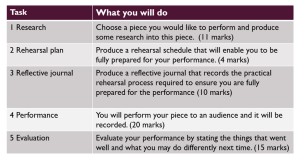For this unit you need to choose an existing piece of music, and perform it to an audience. You will be given a brief to work to.
- A song or piece of music performed on an instrument or voice (can be done solo or in a group)
- A song or piece of music created using a computer program (does not need to be performed live)
Unit 1 can be achieved through music performing or through the use of music technology.
There are 5 tasks to complete:
Task 1 – For the first task learners will need to research possible repertoire, select a piece or pieces to perform, and find out some background information about the piece, then discuss how this will influence their performance. This is worth 11 marks. This is broken down into 6 marks for the actual research and stating the piece or pieces selected, and 5 marks for discussing how this research will impact on the actual performance – considerations of style, any contextual references etc.
Task 2 – Once the learner has decided what they will perform, Task 2 is to plan a rehearsal schedule. This should take into account the demands of the repertoire, any specific techniques required, any need for other people ( other musicians such as an accompanist) and also any equipment needed, or access to particular spaces. For a music technology submission, which will result in a realisation which will not be performed live, this will detail the skills the learner will need to develop in order to use the technology to produce their final audio product. This plan is worth 4 marks.
Task 3 – Task 3 is to produce a reflective journal. There is a suggested 3 hours for this, but it is not a piece of work which can or should be completed in one sitting. Learners should keep a diary of their preparations for their performance, based on their rehearsal schedule, which gives details of what they have achieved in their practice, and what they need to do next time – including if they need to do some individual practice ahead of a group rehearsal. As the title suggests it should be reflective, and should include details of their response to direction, choreography and other feedback, and should make a note of health and safety observations as appropriate. For a music technology candidate producing a recorded realisation this could be a log of their work including considerations of effects they will use in order to produce a particular sound – and their reasons for their choices – or details of equipment they are using and their chosen input methods. Any suitable and appropriate format for the journal will be acceptable.
Task 4 – Task 4 is the performance or presentation of the final piece. There are separate criteria for each discipline here. The repertoire chosen in Task 1 should be of a sufficient complexity to allow learners to demonstrate their performing skills and allow them to achieve the criteria. Learners should perform to an audience who will give them feedback as this will be necessary for the evaluation in Task 5.
Task 5 – Note that there are 15 marks available for Task 5: the evaluation task. It would be wise to look closely at the assessment criteria to ensure that they are fully covered. Teaching activities could include putting yourself in the place of the performer of something you have watched live, or on video, and evaluating what happened and what could be learnt from it for the future. Remember that an evaluation also includes details of what went well and what you might like to make sure you do again in the future.
